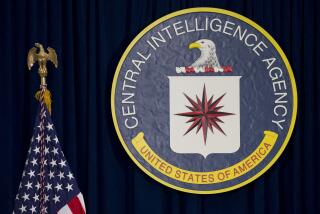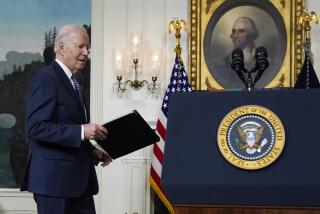Graphic report on CIA interrogations, torture released by Senate panel
The CIA’s brutal interrogations of terrorism suspects between 2002 and 2008 led to false confessions and fabricated information, produced no useful intelligence about imminent terrorist attacks and was so badly run the CIA lost track of captives, according to a long-delayed U.S. Senate investigation report.
The scathing document released Tuesday by the Senate Select Committee on Intelligence reveals previously unknown details so horrific and so graphic that the State Department and the Pentagon warned U.S. embassies and military commanders overseas to prepare for possible protests or even terrorist attacks in response.
LIVE UPDATES: Reaction to the release of the Senate report
The 499-page executive summary, the result of a six-year investigation by committee Democrats, concludes that the CIA routinely provided “extensive inaccurate information” to Congress and the White House about its interrogation techniques, that CIA management of the program was “inadequate and deeply flawed,” and that the methods were “far more brutal” than the CIA has acknowledged.
The conclusions instantly revived a partisan debate over whether the Bush White House permitted waterboarding and other methods so painful they amounted to torture — as well as the dispute over whether they produced clues that ultimately guided the CIA-led raid that killed Osama bin Laden in Pakistan in 2011.
“Under any common meaning of the term, CIA detainees were tortured,” said Sen. Dianne Feinstein (D-Calif.), chairwoman of the Senate intelligence committee, who described some of the gruesome details in an hour-long speech on the Senate floor. She called the CIA program “one of the lowest points in our nation’s history.”
President Obama, who formally ended the CIA interrogation program when he took office in 2009, said the harsh methods “did not serve our broader counterterrorism efforts or our national security interests” and “did significant damage to America’s standing in the world.”
CIA Director John Brennan was far less critical, acknowleging in a statement that the program “had shortcomings and the agency made mistakes” as it struggled to detect terrorist plots after failing to stop the Sept. 11, 2001, attacks.
But Brennan insisted interrogators obtained intelligence “that helped thwart attack plans, capture terrorists, and save lives.”
The report’s ghastly details are reminiscent of the Abu Ghraib prison scandal in Iraq, and suggest a systematic failure of leadership at a time when the agency was also producing faulty intelligence on Saddam Hussein’s supposed weapons of mass destruction, which did not exist.
One detainee in CIA custody was “chained to a wall in the standing position for 17 days” and another looked like “a dog who had been kenneled,” according to a CIA description cited in the report.
Some detainees were kept awake for nearly 180 hours, “usually standing or in stress positions, at times with their hands shackled above their heads.” Some were placed in ice water baths.
At least five captives were subjected to painful rectal rehydration or rectal feeding, without documented medical necessity. In one case, the CIA put a captive’s lunch — hummus, raisins, pasta and nuts — into a blender and inserted the food into his colon through a tube.
The CIA applied its methods “in near nonstop fashion for days or weeks at a time,” the document states.
Some of the agency officers responsible had “documented personal and professional problems of a serious nature — including histories of violence and abusive treatment of others — that should have called into question their employment,” let alone their suitability to run a sensitive CIA program, the report states.
The most gruesome conditions described occurred at a site in a former brick factory north of Kabul, Afghanistan, that was used by the CIA for interrogations starting in November 2002.
In the facility, referred to as “COBALT” in the Senate report but code-named Salt Pit by the CIA, conditions were so dungeon-like that interrogators wore headlamps to navigate pitch-dark passageways.
“At times, detainees there were walked around naked and shackled with their hands above their head,” the report states. “At other times, naked detainees were hooded and dragged up and down corridors while being slapped and punched.”
An Afghan militant named Gul Rahman died in the Salt Pit of suspected hypothermia in November 2002 after he was beaten, stripped naked from the waist down and left chained to a concrete floor in near-freezing temperatures.
The CIA has long admitted to using waterboarding, which simulates drowning by pouring water into a person’s nose and mouth, on three high-ranking Al Qaeda detainees in 2002 and 2003.
But Senate staffers found a photograph in CIA files of a waterboard, a wet floor and buckets of water at the Salt Pit, where the CIA claimed it never used the technique. The CIA was later unable to explain the presence of what investigators called “the well-worn waterboard” at the site.
A career CIA officer who had been internally admonished in the 1980s for misconduct initially was chosen to run the interrogation program. But in 2003, he wrote a message describing his intention to leave the CIA because the interrogation program was a “train [wreck]” and he was “getting off.”
The report raises questions about how much President George W. Bush knew of the detention and interrogation program at the time.
It says the CIA prepared a briefing for him in August 2002, but was told by White House aides that Bush would not receive the report, according to CIA internal messages reviewed by Senate staff.
The CIA’s inspector general recommended that the CIA brief the president in 2004. But no record indicates Bush was briefed until 2006. In a CIA report of that meeting, Bush was described as “uncomfortable” with the description of a detainee chained to the ceiling and left to defecate on himself.
The CIA briefed Vice President Dick Cheney, National Security Advisor Condoleezza Rice, Atty. Gen. John D. Ashcroft and White House Counsel Alberto Gonzales on July 24, 2003, about its treatment of detainees, according to notes by the CIA’s acting general counsel at the time, John A. Rizzo.
The Senate committee reviewed 20 cases where the CIA said its interrogations had led to intelligence successes.
“Each of those examples was found to be wrong in fundamental respects,” the report concludes.
In some cases, investigators found no relationship between the claimed success and any information provided by the detainee. In other cases, the CIA “inaccurately misrepresented that unique information was acquired from a CIA detainee” as a result of the interrogations, when the intelligence was either acquired earlier or was available from other sources.
The methods “regularly resulted in fabricated information,” the report concludes. The CIA “was often unaware” the information was false, however, leading the agency astray as it scrambled to track terrorists and prevent further attacks.
At least 26 of the 119 who were held in CIA custody “were wrongfully held,” the report states. But it adds that a full accounting of how many people were imprisoned, and how they were treated, may never be known “due to poor CIA record-keeping.”
In all, 39 of the 119 detainees were subject to the harsh interrogation techniques between 2002 and 2008, the report found.
The detention program began after Bush signed a classified covert action memorandum six days after the Sept. 11, 2001, attacks that killed nearly 3,000 people.
The spy service subsequently built and ran “black sites,” or secret prisons, in Thailand, Poland, Romania, Afghanistan and elsewhere. The names of the countries are blacked out in the unclassified report.
On Feb. 7, 2002, Bush signed a separate memo stating that the Geneva Conventions requiring humane treatment of prisoners in a conflict did not apply to Al Qaeda or Taliban detainees.
Legal authorization to use harsh interrogation methods came on Aug. 1, 2002, when the Justice Department’s Office of Legal Council issued two memos concluding that the CIA’s proposed “enhanced interrogation techniques” did not violate federal anti-torture laws.
The first waterboarding, against Al Qaeda operative Abu Zubaydah, who was captured in Pakistan, began three days later and continued for nearly a month, the report says.
During one session, he became “completely unresponsive with bubbles rising through his open full mouth,” the report states.
Contrary to subsequent CIA claims, agency personnel were instructed to give the interrogations priority over medical care for Zubaydah, who had been shot in the thigh, abdomen and stomach during his capture.
A second Al Qaeda suspect, Abd al Rahim al Nashiri, was waterboarded at the same CIA site that November. While in custody, he was also threatened with a handgun and an electric drill.
In March 2003, Khalid Shaikh Muhammad, the self-described mastermind of the Sept. 11 attacks, was captured and subjected to coercive interrogation, including 183 instances of waterboarding.
Muhammad repeatedly provided false information under questioning. He confirmed an intelligence tip that Al Qaeda had a cell of African American operatives in Montana. The FBI assigned field agents to chase the lead, but came up empty.
In November 2005, contrary to directions from the Bush White House and the office of the Director of National Intelligence, the director of the CIA’s National Clandestine Service, Jose Rodriguez, authorized the destruction of videotapes of the waterboarding of Zubaydah and Nashiri.
The Senate report is based on 6.3 million pages of CIA internal cables, emails, chat logs and other communications, as well as interviews conducted by the CIA’s inspector general and the agency’s internal history of the interrogation program.
The executive summary was declassified, with some sections blacked out to protect the identity of CIA officers and some countries that hosted “black sites.”
Investigators were not permitted to speak to the CIA interrogators because of concerns about disrupting a Justice Department inquiry. Republicans on the committee also withdrew from participating in the study in 2009 because of the ongoing criminal investigation.
The Republicans did not rejoin the investigation when President Obama announced in April 2009 that prosecutors would not press criminal charges against CIA officials who participated in interrogations consistent with the legal memoranda issued under the Bush administration.
The full classified report is more than 6,700 pages long and will not be released.
More to Read
Start your day right
Sign up for Essential California for news, features and recommendations from the L.A. Times and beyond in your inbox six days a week.
You may occasionally receive promotional content from the Los Angeles Times.






